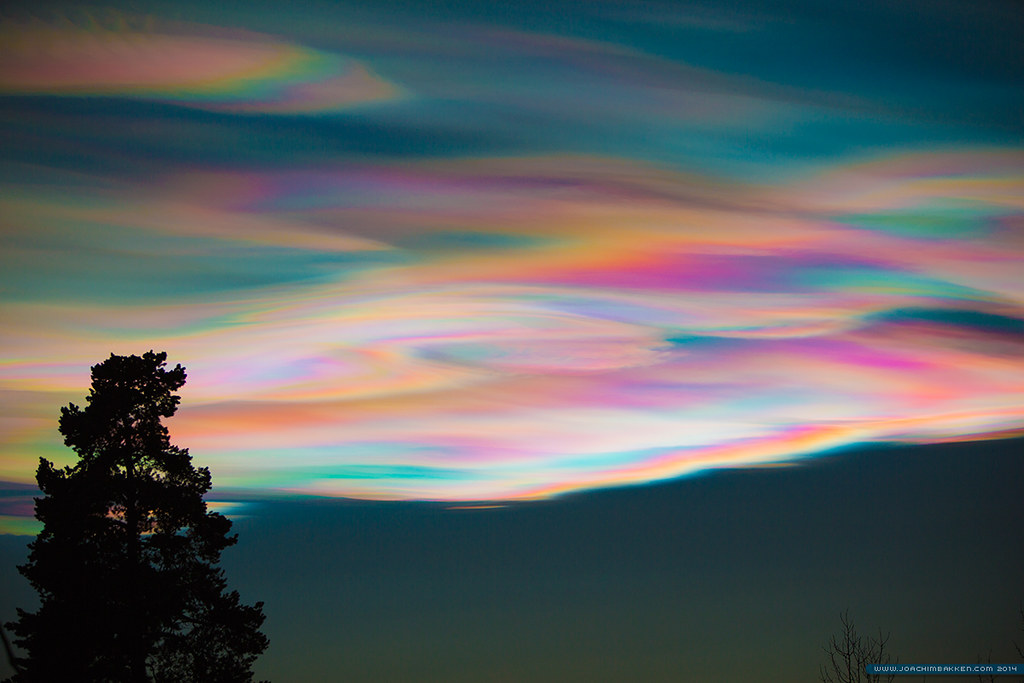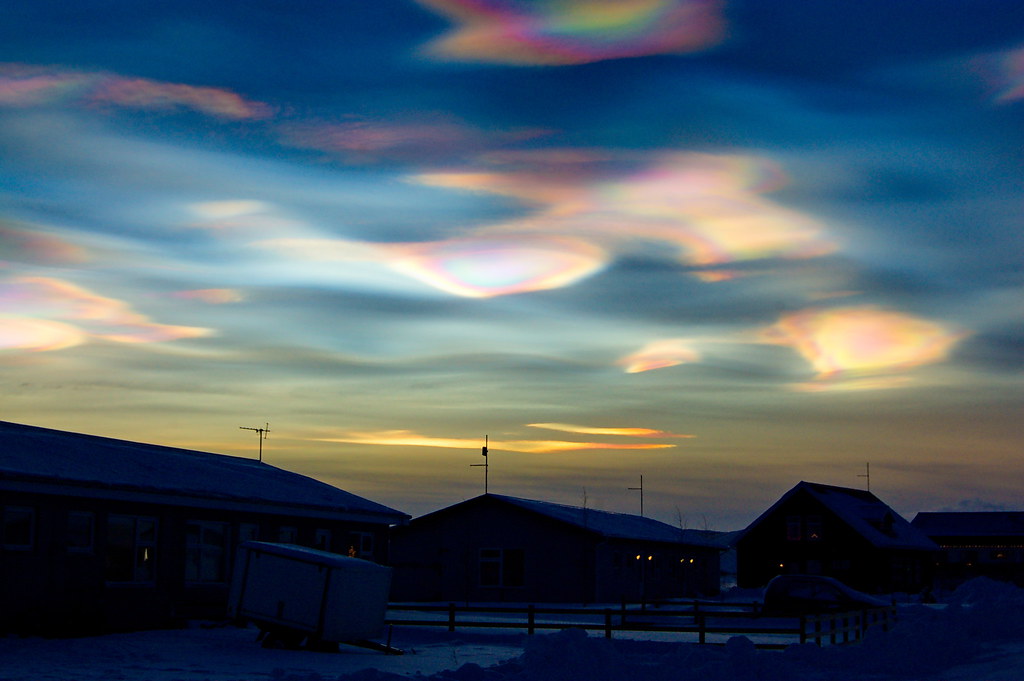Sometimes deep into the winter, after sunset or before dawn, sheets of unbelievably bright and vividly colored clouds can be seen forming against the partially dark twilight sky. This rare type of cloud formations are known as “polar stratospheric clouds” or “nacreous clouds”, and they can only be seen from high latitude regions such as Iceland, Alaska, Northern Canada, the Scandinavian countries and Antarctica. The Scandinavians call them “mother of pearls” because of their spectacular iridescent colors. Described as “one of the most beautiful of all cloud formations,” nacreous clouds are also the most destructive to our atmosphere. Their presence encourages a chemical reaction that breaks down the ozone layer, which is an essential shield protecting us from the sun's harmful rays.

Photo credit: marawaca/Flickr
Nacreous clouds develop at very high altitudes, within the lower stratosphere at 70,000 feet or above. For comparison, some of the highest clouds in the troposphere have a ceiling height of about 40,000 feet.
Clouds generally do not form in the stratosphere because there is not enough moisture. But nacreous clouds are different. They are not entirely composed of water droplets, but a mixture of naturally occurring water and nitric acid that comes from industrial sources.
Decades ago, we started using substances such as chlorofluorocarbons (CFCs) in aerosols and refrigeration. These chemicals have been phased out, but they are so stable they persist to this date. CFCs take several years to rise through the troposphere until they reach the stratosphere where they begin to break down by ultraviolet light producing free chlorine atoms. Like any free radicle, chloride ions are very reactive and they go on a rampage attacking and destroying the ozone layer.

Photo credit: Stefan Tariczky/Flickr
Thankfully, ozone is not the only molecule the chlorine atom reacts with. They also interact with other chemicals in the atmosphere to form two very stable compounds —hydrochloric acid and chlorine nitrate. These two compounds have locked up the majority of chlorine in the stratosphere, keeping them out of harm’s way.
But during the long winter months in the polar regions where there is little sunlight, temperature becomes so frigid in the stratosphere that clouds begin to form despite the air being so thin and dry. These nacreous clouds, formed out of frozen crystals of water, nitric acid and sometimes sulphuric acid, provide an ideal surface upon which chemical reactions occur that release the free chlorine atoms back into the atmosphere. The presence of sunlight is essential to the equation, so this happens only during spring when sunlight returns to the poles, and ultraviolet light break the bonds between the chlorine atoms. The process can only stop once the nacreous clouds are destroyed by air flows from lower latitudes.
Such chemical reactions could not take place anywhere else in the atmosphere. This is why the ozone hole is more prominent in the polar regions than elsewhere. Also, nacreous clouds are more commonly observed in the southern hemisphere. Consequently, the ozone layer is more depleted over the south pole, compared with the north pole.
Also read: Upside Down RainbowsandFire Rainbows

Photo credit: Alice/Flickr

Photo credit: Florentin Moser/Wikimedia

Photo credit: Eirik Newth/Flickr

Photo credit: Christoffer Glosli/Flickr

Photo credit: Thoth God of Knowledge/Flickr

Photo credit: Alan Light/Flickr

Photo credit: Finnur Malmquist/Flickr

Photo credit: See Shinn/Flickr

Photo credit: Sandwich/Flickr



Photo credit: Alice/Flickr
Sources: NASA / Ozone Hole Watch / Atoptics / The Guardian
Subscribe to our Newsletter and get articles like this delieverd straight to your inbox

Photo credit: marawaca/Flickr
Nacreous clouds develop at very high altitudes, within the lower stratosphere at 70,000 feet or above. For comparison, some of the highest clouds in the troposphere have a ceiling height of about 40,000 feet.
Clouds generally do not form in the stratosphere because there is not enough moisture. But nacreous clouds are different. They are not entirely composed of water droplets, but a mixture of naturally occurring water and nitric acid that comes from industrial sources.
Decades ago, we started using substances such as chlorofluorocarbons (CFCs) in aerosols and refrigeration. These chemicals have been phased out, but they are so stable they persist to this date. CFCs take several years to rise through the troposphere until they reach the stratosphere where they begin to break down by ultraviolet light producing free chlorine atoms. Like any free radicle, chloride ions are very reactive and they go on a rampage attacking and destroying the ozone layer.

Photo credit: Stefan Tariczky/Flickr
Thankfully, ozone is not the only molecule the chlorine atom reacts with. They also interact with other chemicals in the atmosphere to form two very stable compounds —hydrochloric acid and chlorine nitrate. These two compounds have locked up the majority of chlorine in the stratosphere, keeping them out of harm’s way.
But during the long winter months in the polar regions where there is little sunlight, temperature becomes so frigid in the stratosphere that clouds begin to form despite the air being so thin and dry. These nacreous clouds, formed out of frozen crystals of water, nitric acid and sometimes sulphuric acid, provide an ideal surface upon which chemical reactions occur that release the free chlorine atoms back into the atmosphere. The presence of sunlight is essential to the equation, so this happens only during spring when sunlight returns to the poles, and ultraviolet light break the bonds between the chlorine atoms. The process can only stop once the nacreous clouds are destroyed by air flows from lower latitudes.
Such chemical reactions could not take place anywhere else in the atmosphere. This is why the ozone hole is more prominent in the polar regions than elsewhere. Also, nacreous clouds are more commonly observed in the southern hemisphere. Consequently, the ozone layer is more depleted over the south pole, compared with the north pole.
Also read: Upside Down RainbowsandFire Rainbows

Photo credit: Alice/Flickr

Photo credit: Florentin Moser/Wikimedia

Photo credit: Eirik Newth/Flickr

Photo credit: Christoffer Glosli/Flickr

Photo credit: Thoth God of Knowledge/Flickr

Photo credit: Alan Light/Flickr

Photo credit: Finnur Malmquist/Flickr

Photo credit: See Shinn/Flickr

Photo credit: Sandwich/Flickr



Photo credit: Alice/Flickr
Sources: NASA / Ozone Hole Watch / Atoptics / The Guardian
Subscribe to our Newsletter and get articles like this delieverd straight to your inbox
Polar Stratospheric Clouds And Its Dark Secret
4/
5
Oleh
Chandu Numerology










